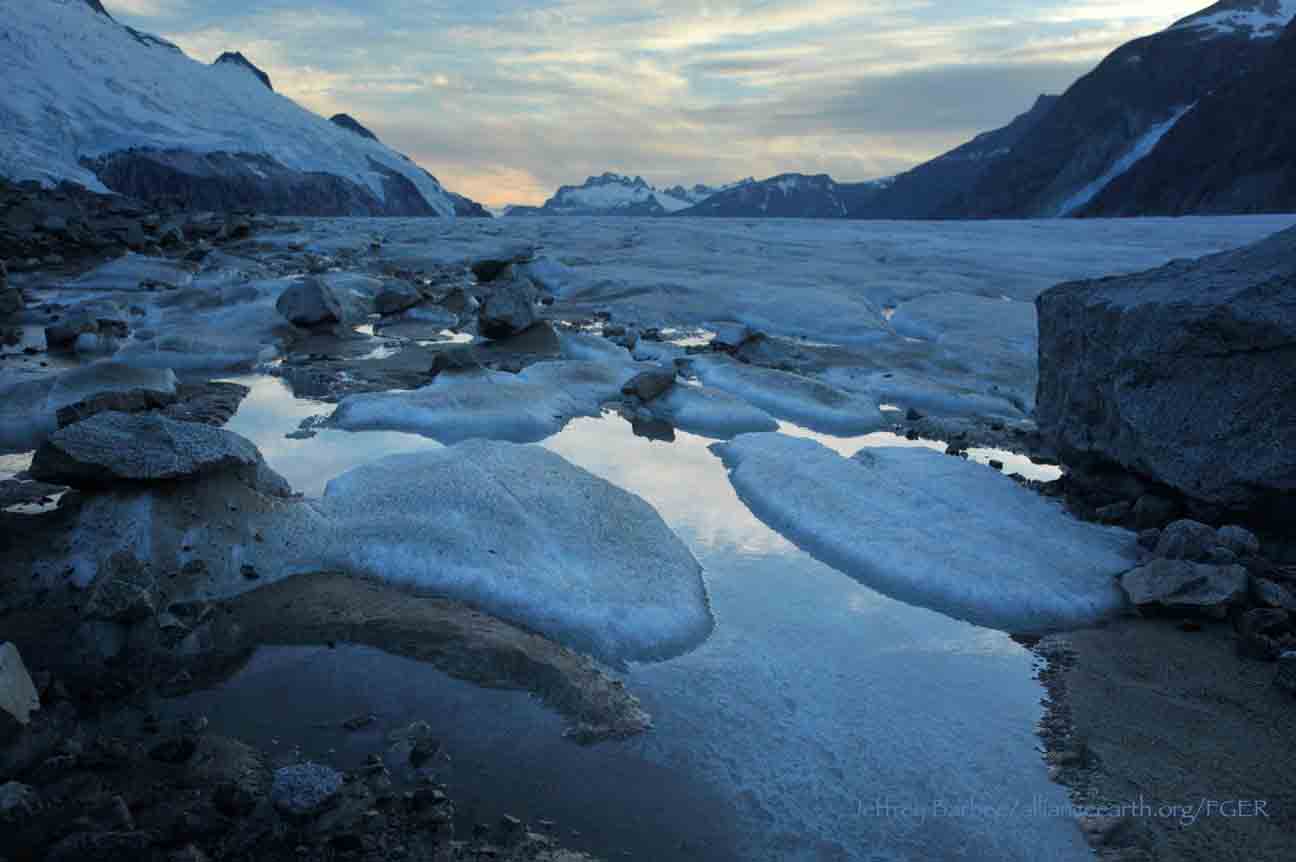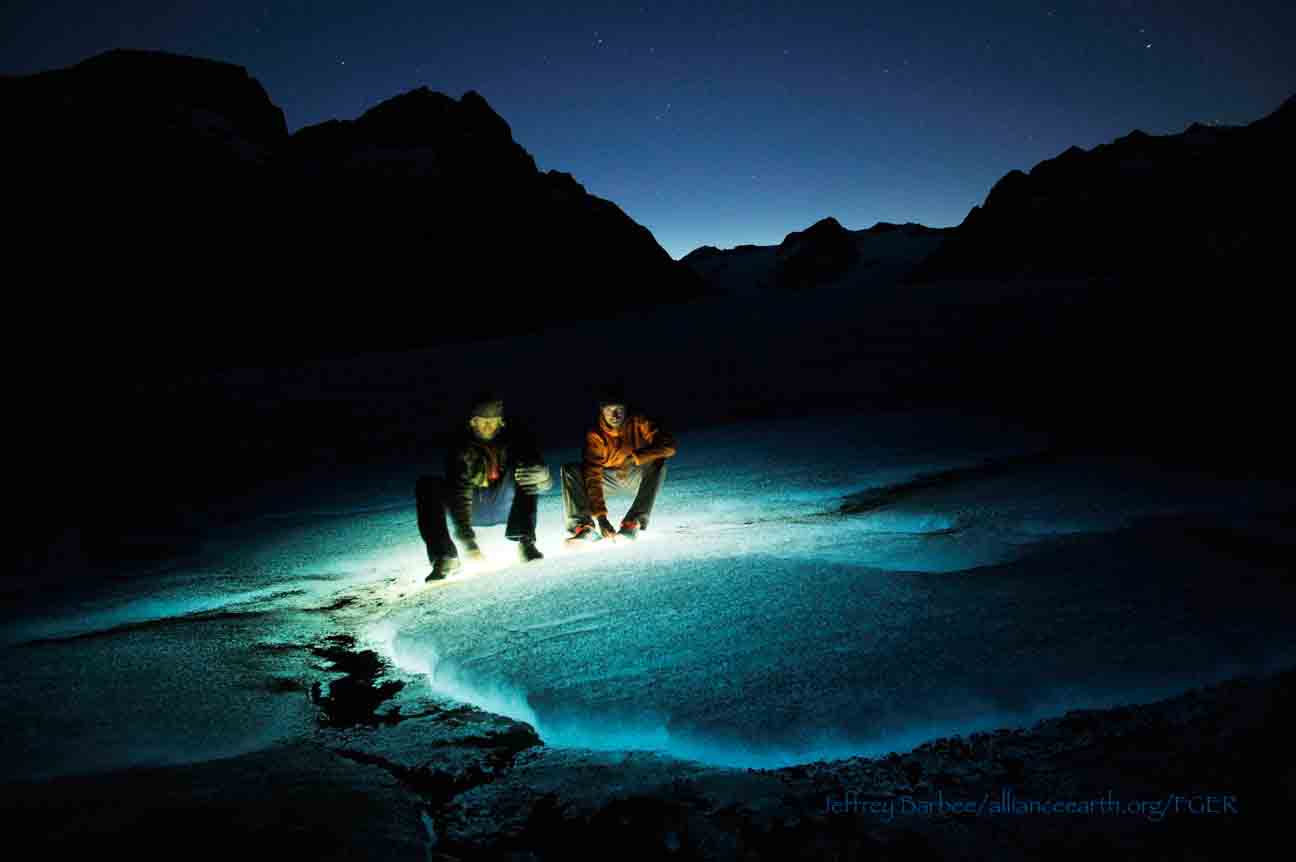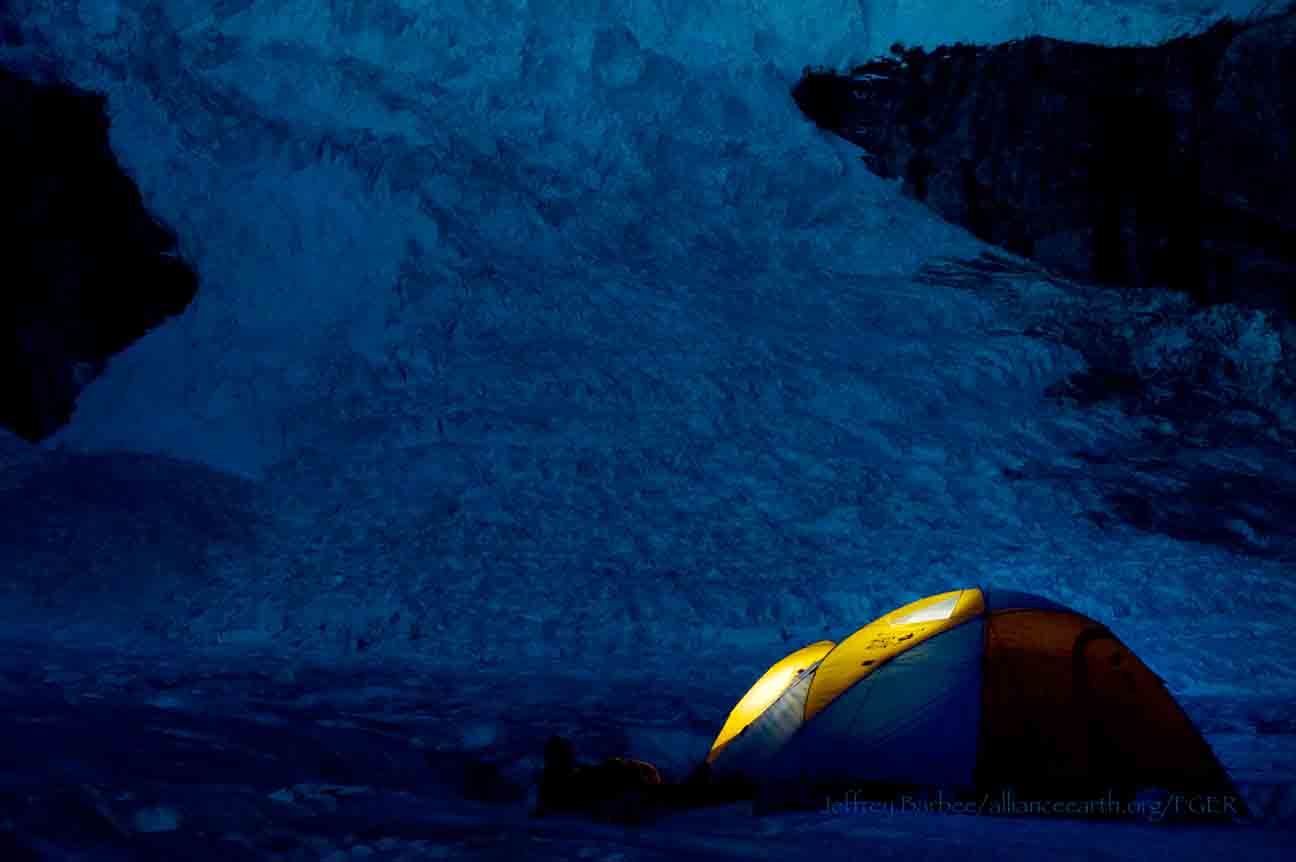Kit Cunningham, Montana State University
Annie Zaccarin, University of California, San Diego
As the sun warmed the rocks and the clouds drifted away from Camp 18, the biogeochemistry research group skied up and away from camp. The weather was pleasant. A glacial breeze cooled us as we gleefully kicked and glided our way across the icefield towards the Matthes-Llewellyn divide. The divide is a topographic high between the two glaciers, from which point the ice flows downhill and away in both directions. Our research group aimed to gather snow samples from the past years’ snowpack on the Llewellyn Glacier to analyze in a lab.
We arrived at our location, roughly halfway between the two sides of the Llewellyn Glacier, on a relatively flat area downhill of the divide. Enthusiastic to start working, we kicked off our skis and set up our work area amid the ever glorious snow and mountain peaks surrounding us. The first step was to dig a trench roughly 1.5 m by 3 m, and 1 m deep. We used the excavated snow to build a shade wall on the south side of the work area, protecting sensitive samples from the sun. This trench and wall created our main workstation, a sort of subterranean workbench where we could comfortably stand and use the top of the snowpack as a waist-high counter top. After this our team prepared to gather snow samples by pulling up snow cores from the depths of the snow beneath our feet, just to the side of the trench. We all picked a job to start at on our snow core assembly line and enthusiastically got ready for a day of collecting samples.
The snow core assembly starts with gathering the snow core itself. This consisted of 3 main parts: the snow corer, the flights, and the handle. The snow corer is a tube about 1.5 m long, with plastic threads down the outside connecting to sharp teeth, and metal latches in the inside, also known as ‘dogs’ (Fig. 1). The snow corer acts like a hollow screw, with the plastic threads on the side helping to guide it straight downward as the sharp teeth cut into the snow. The metal latches are at the inside bottom of the tube, which prevent the snow core from sliding out when the snow core is brought to the surface.
Figure 1. Image of the bottom of a snow corer. Photo Credit: Kovacs Enterprise; Ice Drilling and Core Equipment
A flight, the second section of the set up, is a meter-long attachment to the handle. It is meant to increase the depth of the coring hole. Basically, once the snow corer is deeper than its own height (1.5 m), we need additional attachments in able to retrieve it. A flight is one meter long, so if the snow core hole is 10 m deep, we need to attach 10 flights to the handle to drill and recover the core. The last piece of the snow corer set up is the handle. This is where all the power comes from, with our own arm strength. We operate the drill by turning the T-shaped handle, slowly spinning the whole apparatus and drilling the corer deep into the snow.
Caption: Kit Cunningham and Chris Miele adding flights to the drill (partly lowered in the hole). Photo credit: Sarah Fortner
Once the snow corer is set up, we began the core extraction. I started out at the beginning of the assembly line, pulling the snow core out of the hole; which in my opinion is the most fun job. Using the snow core assembly, I pulled out our first segment of snow and slid it out of the snow corer and onto our workbench. Since extra snow shavings, or filings, from the threads of the snow corer can gather on top of the snow core sample itself, we measured both the depth of the hole and the length of the snow core and compared the measurements. If the snow core sample was longer than the depth of the hole, we removed the excess snow (filings from the side and top of the hole). As the snow core assembly went deeper, more filings got into the core, and this discrepancy increased. After we matched our snow core sample to the depth of the hole, the next two people in the assembly line, the snow core sawer, cut the snow core into 10 cm segments. We treated each of these 10 cm segments as individual samples. We measured the top and bottom diameters and the mass of each segment using a field scale, so that we could calculate the density of the sample later. The next person in the assembly line, the master note keeper, carefully recorded all these measurements. The master note keeper also kept track of any ice lenses, layers of ice within the snow core, in each sample. The master note keeper handed off the baggie holding the snow core segment to yet another member of the assembly line, the snow core pulverizer. The snow core pulverizer had perhaps the most entertaining job, breaking the snow core up into tiny little pieces. Accomplished via fist pounding and sometimes the use of a hammer, the goal is to break up and mix all of the snow core segment particles together, to make them as uniform in size as possible. Because we did not have enough sample bottles, or helicopter space, to carry out the entire snow core, we filled two sample bottles with the pulverized snow from each 10 cm segment. Pulverizing the segment helps ensure that the snow core pieces bottled are representative of the entire 10cm segment and not just the top or bottom part. Last, but not least of our tasks, the bottle labeler was responsible for marking all the sample bottles with the core segment label, so that back at the lab everyone knows which bottle goes with which part of the snow core.
Caption: Field staffer Matt Pickart and faculty member Natalie Kehrwald measure the snow core section, camouflaged on the snow workbench. Biogeochemistry students Molly Peek, Annie Holt, and faculty member Sarah Fortner bottle and label samples in the background.
Photo credit: Annie Zaccarin.
These snow cores will travel, from our backpacks, hundreds of miles via helicopter, car, and airplane to get to a laboratory to be tested for inclusions. These inclusions will function as proxies for different characteristics and changes occurring on the Icefield. The inclusions we will be testing for are isotopes, major ion content, snow density, levoglucosan (which is a chemical produced through burning plant biomass), and dust particles. Through these five things, we will be able to understand changing precipitation and wind patterns, temperature fluxes, types of rock surrounding the glaciers, and the quantity of forest fires in the area and if they are affecting the Icefield melt. Independently, each test is a little clue about the Icefield health and together it can make a more encompassing picture.
The Juneau Icefield is the fifth largest Icefield in the western hemisphere and determining whether changes are occurring, such as increased precipitation or ash deposits, are important factors in hypothesizing its present and future melt patterns. Since these cores can go back approximately 3-5 years depending on depth, we can compare this year’s annual melt, precipitation, and wind data to previous year’s data as a way to put current changes into perspective. Through these little microscopic changes in the snow, we can gain huge amounts of information on the Icefield's present and future health. And this whole process starts with a group of excited students enjoying the day and stuffing snow inside small bottles.
This brings us back to our makeshift conveyor belt of snow chunks, and what marked the end of the day’s sample collection. Our snow core reached an impressive 9.2 meters depth, which contains snow dating back 3-4 years. We packed the hundreds of sample bottles away into our bags, ready to be carry them back to camp. After taking off a layer and grabbing a quick snack, we all put on our skis and started the long trek back to camp for supper. We gazed at the tall, mountainous beauty of the Storm Range, hypothesized about what might be cooking for supper, and reflected on how lucky we are to learn science in a place as wonderful as the Juneau Icefield.
To learn more about the potential links between snow cores and forest fires, take a listen to this podcast by Elizabeth Jenkins about our group’s snow coring on the icefield.
The JIRP 2017 Biogeochemistry team at Camp 18. From left to right: Kiana Ziola, Dr. Sarah Fortner, Auri Clark, Molly Peek, Annie Zaccarin, Kit Cunningham, Annie Holt, Chris Miele and Dr. Natalie Kehrwald.













